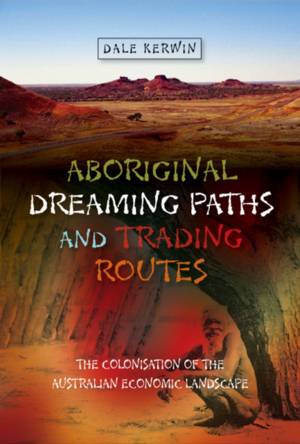
- Afhalen na 1 uur in een winkel met voorraad
- Gratis thuislevering in België vanaf € 30
- Ruim aanbod met 7 miljoen producten
- Afhalen na 1 uur in een winkel met voorraad
- Gratis thuislevering in België vanaf € 30
- Ruim aanbod met 7 miljoen producten
Zoeken
Aboriginal Dreaming Paths and Trading Routes
The Colonisation of the Australian Economic Landscape
Kerwin
€ 90,95
+ 181 punten
Uitvoering
Omschrijving
The dreaming paths of Aboriginal nations across Australia formed major ceremonial routes along which goods and knowledge flowed. These became the trade routes that criss-crossed Australia and transported religion and cultural values. This book highlights the valuable contribution Aboriginal people made in assisting European explorers, surveyors and stockmen to open the country for colonisation, and explores the interface between Aboriginal possession of the Australian continent and European colonisation and appropriation. Instead of positing a radical disjunction between cultural competencies, Dale Kerwin considers how European colonisation of Australia appropriated Aboriginal competence in terms of the landscape: by tapping into culinary and medicinal knowledge, water and resource knowledge, hunting, food collecting and path-finding. As a consequence of this assistance, Aboriginal dreaming paths and trading routes also became the routes and roads of colonisers. Indeed, the European colonisation of Australia owes much of its success to the deliberate process of Aboriginal land management practices. Dale Kerwin provides a social science context for the broader study of Aboriginal trading routes by setting out an historic interpretation of the Aboriginal/European contact period. His book scrutinises arguments about nomadic and primitive societies, as well as Romantic views of culture and affluence. These circumstances and outcomes are juxtaposed with evidence that indicates that Aboriginal societies are substantially sedentary and highly developed, capable of functional differentiation and foresight -- attributes previously only granted to the European settlers. The hunter-gatherer image of Aboriginal society is rejected by providing evidence of crop cultivation and land management, as well as social arrangements that made best use of a hostile environment. This book is essential reading for all those who seek to have a better knowledge of Australia and its first people: it inscribes Aboriginal people firmly in the body of Australian history.
Specificaties
Betrokkenen
- Auteur(s):
- Uitgeverij:
Inhoud
- Aantal bladzijden:
- 256
- Taal:
- Engels
- Reeks:
Eigenschappen
- Productcode (EAN):
- 9781845193386
- Verschijningsdatum:
- 12/10/2010
- Uitvoering:
- Hardcover
- Formaat:
- Genaaid
- Afmetingen:
- 173 mm x 246 mm
- Gewicht:
- 566 g

Alleen bij Standaard Boekhandel
+ 181 punten op je klantenkaart van Standaard Boekhandel
Beoordelingen
We publiceren alleen reviews die voldoen aan de voorwaarden voor reviews. Bekijk onze voorwaarden voor reviews.











